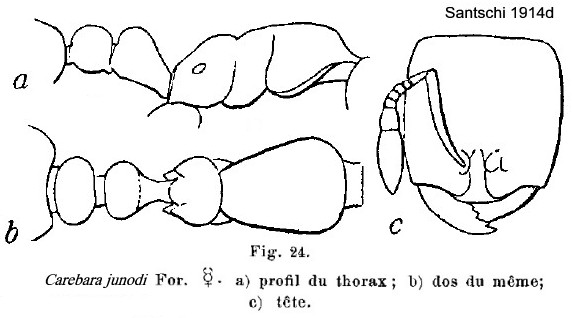Carebara junodi Forel
 queen - queen - 
 Type location South
Africa (Carebara Junodi n.
sp., Forel, 1904a: 154, queen - not on Antweb, November 2018; Forel, 1909b: 53, male; Forel,
1913b; 336, worker) Shilouvane, H Junod; all forms described (see
Bolton, 1995) Type location South
Africa (Carebara Junodi n.
sp., Forel, 1904a: 154, queen - not on Antweb, November 2018; Forel, 1909b: 53, male; Forel,
1913b; 336, worker) Shilouvane, H Junod; all forms described (see
Bolton, 1995)  . .
|
 Forel's
(1904a) description of the queen is at Forel's
(1904a) description of the queen is at  .
Forel's
(1913b) description of the worker is at .
Forel's
(1913b) description of the worker is at  . Arnold (1916: 252) gave a translation,
this is at . Arnold (1916: 252) gave a translation,
this is at  . .
Forel (1909b) reducing it to the status of a subspecies
of vidua (later revived by Santschi, 1914d: 364, in key) argued
that the distinctive characters of the clypeus, head, etc. varied among
individuals. Katange females had a gaster which was reddish but with
straight brown bands across the junctions of the segmens, in the type
of vidua the gaster is brown with straight basal yellow bands
on the segments. The males were a little longer than vidua but
with a stronger yellow gaster.
Santschi (1935a: 263), writing about a worker specimen
from Zaïre, Lumbumbashi (then Elizabethville), collected by Dr
Gerard, noted - this species has mandibles with the terminal border
very oblique and armed with three teeth; the two apical teeth very
strong and separated from the third by a longer interval; behind these
the terminal border is also prolonged, sometimes with and sometimes
without a denticle or two - hence the "four teeth" mentioned in his
earlier key. By comparison with earlier specimens the antennal club is
more slender, with the first segment as wide as long (as with arnoldi).
|